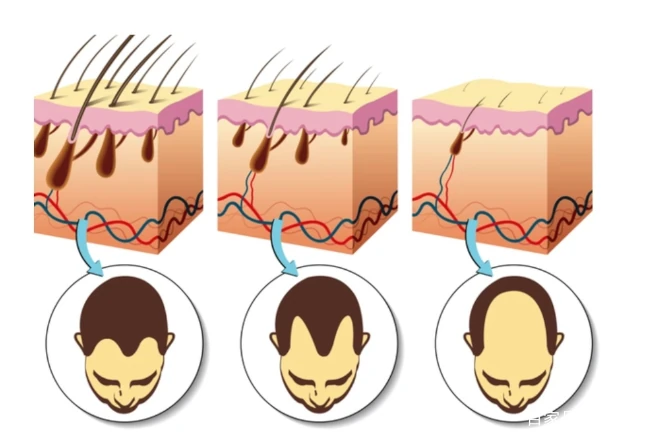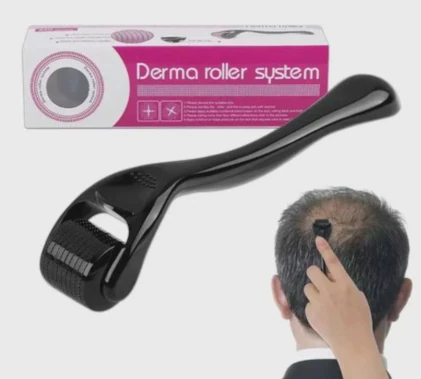How to Use a Derma Roller for Hair Growth: The Complete Guide
Although hair loss may be annoying and upsetting, microneedling with a derma roller is a convenient and harmless style to promote hair growth. It is a scientifically-backed, dermatologists-recommended technique that can strengthen hair follicles, promote hair regrowth, and improve the health of the scalp. Here, we break down how microneedling works, how to achieve the best results with a derma roller, the new innovations in instruments, what treatments work best as adjuncts, and what you need to know to avoid safety pitfalls.


1. Does Derma Rolling Work For Hair Growth/And Hair Loss?
How Microneedling Works
Microneedling (Also called, Collagen Induction Therapy) – Involves using a derma roller (or derma stamp) with tiny needles that prick the scalp to create micro-injuries. These small, controlled wounds induce the body’s natural healing process, improving blood circulation in the scalp and promoting collagen and growth factor production. This eliminates, purifies and replenishes hair follicles, which may stimulate dormant follicles and help diminish hair thinning.
What Research Says
Numerous studies have demonstrated the positive effects of microneedling on hair growth, particularly when used in conjunction with topical applications such as minoxidil:
- Minoxidil Microneedling: 2013 study published in International Journal of Trichology compared minoxidil microneedling to minoxidil alone and found that microneedling with minoxidil led to much better results when combined. With both methods combined, participants had an average 91 new hairs per square centimeter after 12 weeks, vs 22 hairs with using minoxidil alone.
- In Case of Androgenetic Alopecia: Study by Dhurat et al. showed that weekly microneedling over 12 weeks led to hair regrowth in men and women with androgenetic alopecia. In theory, this implies that microneedling can stimulate hair follicles and make the scalp thicker, thus allowing for a fuller head of hair.
2. Choosing the Right Derma Roller
Reusable and very easy to use, a derma roller for hair growth can be used at home just like using a face roller but using the right needle size is essential.
- 0.25mm: Beginner needle, can be used every other day. But it may not go deep enough to really stimulate follicles.
- 0.5mm: Perfect for most at-home users, this depth is sufficient to stimulate the follicles without being too irritating. Best for 1–3 times a week; up to 3 times a week is recommended.
- 1.0-1.5mm — More aggressive stimulation but should be used with caution. These are typically used once every 10-14 days or even 3-4 weeks to prevent irritation from extensive use.
For safe, long-term use, choose a dermaroller that is made out of medical-grade stainless steel or titanium, which will last a lot longer without becoming dull. In fact, the majority of derma rollers are packaged with a case that protects the roller from harm and keeps it hygienic.
3. The How-To: How to Use a Derma Roller for Hair Growth
Step-by-Step Guide
- Cleanse Your Scalp — Wash your hair first with a mild shampoo. Let it dry completely.
- Sanitize the Derma Roller: Soak your derma roller in rubbing alcohol for 5-10 minutes, then let it air dry.
- Divide hair in sections to ensure that every part of the hair gets equality of attention.
- Roll in Different Directions: Lightly roll both horizontally and vertically for each section of scalp. Use little pressure; 3-5 passes in each area.
Combining with Minoxidil or Growth Serums
Apply minoxidil or hair growth serum 20-30 minutes after the rolling session. Microneedling increases absorption of active ingredients by creating micro-channels in the scalp. However, if you do use an oil or serum prior to the microneedling make sure to give the roller a thorough clean afterwards to avoid contamination.
Frequency of Use
You may use a 0.5 mm roller 1-3 times weekly, but needled 1.0 mm or longer should only be used every 10–14 days for most users. A 0.2-0.25 mm roller is said to be effective in stimulating circulation, but does not penetrate as deeply, making it a popular daily option among some dermatologists who worry about irritation.
4. Possible Side Effects and When to Cease
Common Side Effects
- Redness and Irritation: Redness is typical post microneedling and can be expected, usually disappearing within a few hours.
- Swelling: Some, with the bigger needles you could experience mild swelling but this should be short lived.
When Not to Do Microneedling
- Active scalp conditions: Scalp conditions like psoriasis, eczema, or aggressive dandruff may get aggravated with microneedling.
- Open Wounds or Infections: Microneedling should never be performed on the scalp if there are open wounds or infections.
DO opt for a roller that suits your skin type. If you feel persistent pain, more hair shedding, or indications for an infection, stop using the roller and see a dermatologist.
5. How Long Does Microneedling Take To Regrow Hair?
Outcomes differ but here is a general timeframe of what to expect:
- 4-6 Weeks: You may begin to see results, such as reduced falling hair and a scalp that feels healthy.
- 2-6 Months: If you are consistent with microneedling, you may begin to see more hair coming in. Results will be most likely with minoxidil.
- 6-12 Months: Full results, as microneedling is a gradual process that requires consistent use for best outcomes.
These results can only be achieved provided one sticks to the regular treatments and complementing products.
6. Microneedling Tools–New Versions/Innovations
The latest tools available (or under study) in microneedling, will make sure to improve the experience and result:
- Motorized Derma Pens: They have adjustable depth and auto speed so they can more accurately target the skin and arguably cause less discomfort than rollers, especially at longer lengths.
- LED Light-Infused Rollers: A few newer rollers actually have red light built into them. Studies suggest that red light can increase blood flow to an area and may stimulate collagen production. In conjunction with microneedling, LED light therapy may help nourish the scalp and promote hair growth.
- Ce-MNs (Ceria Nanozyme (CeNZ)-integrated Microneedles Patch): It can alleviate oxidative stress and promote angiogenesis simultaneously to reshape the perifollicular microenvironment for AGA treatment. However, This method is still at research phase though very promising results have achieved on lab mouse. ( Ref: Ceria Nanozyme-Integrated Microneedles Reshape the Perifollicular Microenvironment for Androgenetic Alopecia Treatment. ACS Publications 2021)
For dedicated users, these tools may come at a slightly high cost but allow more control and efficiency which makes it worth investing.
7. Microneedling-Accompanying Natural Remedies
Integrating natural treatments with microneedling is a growing trend, as certain oils can improve scalp health and potentially stimulate growth.
- Peppermint Oil: Data from some studies indicate that peppermint may promote new hair growth through increased blood circulation to the scalp.
- Rosemary Oil: Rosemary oil is a natural post-microneedling application which has been shown to be effective (though not effective as topical 5% minoxidil for hair regrowth).
8. How to Maintain and Store Your Derma Roller?
Post-Use Cleaning
Rinse your roller under warm water after each session and disinfect it by soaking it in alcohol for about 5-10 minutes. Let it air dry completely.
Proper Storage
Keep your roller in a pouch in a dry, clean, sunless place. If the needles are damaged or blunt, replaces it.
9. Tips from the Experts — Dermatologists
These tips from top dermatologists help you get the most out of microneedling:
- Avoiding Shampoo for 24 Hours : This ensures that the scalp heals and allows any irritation from shampoo or other styling products to subside.
- Apply SPF on the Scalp: The scalp will be more exposed to direct sunlight after microneedling, so be sure you’re protecting this area!
- Do not overdo it: Using it more often will not yield better results and can irritate the skin. The frequency of use depends on the needle size and how sensitive you are to the treatments.
Conclusion
Using a derma roller allows for a research-validated technique to promote hair growth through microneedling. If you want to optimize your chances for success: using the right tools, following a consistent treatment schedule and incorporating some of the beneficial serums or oils into your regular routine. Please be patient, as results don’t happen overnight, and seek the advice of a dermatologist if there is any doubt.








